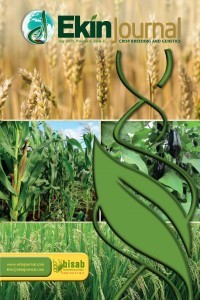Determination of Yield Performances of Oleic Type Sun ower (Helianthus annuus L.) Hybrids Resistant to Broomrape and Downy Mildew
Determination of Yield Performances of Oleic Type Sun ower (Helianthus annuus L.) Hybrids Resistant to Broomrape and Downy Mildew
sunflower, oleic acid, hybrid, yield, broomrape, downy mildew, resistance,
___
- Baydar H and Erbaş S (2005). Influence of Seed Development and Seed Position on Oil, Fatty Acids and Total Tocopherol Contents in Sunflower (Helianthus annuus L.) Turkish Journal of Agriculture and Forestry. 29: 179-186.
- Demurin Y and Borisenko O (2011). Genetic collection of oleic acid content in sunflower seed oil. Helia, 34 (55): 69-74
- Evci G, Kutni R, Kaya Y, Pálvölgyi L, Tar M, Paricsi S, Pekcan V, Gucer T and Yilmaz IM (2009).
- Yield performances of oleic type sunflower hybrids in Turkey and Hungary. International Scientific Conference “Good Practices for Sustainable Agricultural Production”. 12-14 November. Sofia, Bulgaria. 185-193.
- Evci G, Pekcan V, Yilmaz MI and Kaya Y (2011a). The Determination Resistance of Some Sunflower Lines Against to Downy Mildew (Plasmopara halstedii (Farl.) Berl. & De Toni.) in Trakya Region. Anadolu, 21(1): 36-43.
- Evci G, Sezer N, Pekcan V, Yilmaz IM and Kaya Y (2011b). Broomrape control in sunflower production in Turkey. International Symposium on Broomrape (Orobanche spp.) Sunflower. Journal of Academy of Science of Moldova. 2 (314): 111-117.
- Fernandez Martinez JM, Perez Vich B and Velasco L (2009). Sunflower. In: Oil Crops, Handbook of Plant Breeding, V.4, Vollmann, J. and Rajcan, I. (eds.), Springer, 155- 232
- Fernandez Martinez JM, Velasco L and Pérez Vich B (2013). Progress in Research on Breeding for Resistance to Sunflower Broomrape. Helia. 35 (57): 47-56
- Izquierdo NG, Aguirrezábal LN, Andrade FH and Cantarero MG (2006). Modeling Response of Fatty Acid Composition to Temperature in a Traditional Sunflower Hybrid. Agronomy Journal 98: 451-461.
- Jocić S, Cvejić S, Hladni N, Miladinović D and Miklič V (2010). Development of sunflower genotypes resistant to downy mildew. Helia, 33 (53): 173-180.
- Kaya Y, Kaya V, Şahin İ, Üstün Kaya M, Evci G and Çıtak N (2008). The Future Potential of Oleic Type Sunflower in Turkey. Proc of 17th International Sunflower Conference, Cordoba, Spain. June 8-12. International Sunflower Assciation. 2: 791-796.
- Kaya, Y, Evci G, Pekcan V, Gucer T and Yilmaz IM (2009). The Evaluation of Broomrape Resistance in Sunflower hybrids. Helia. 32 (51): 161-169.
- Kaya Y, Evci G, Pekcan V, Gucer T, Yilmaz IM, Şahin I, Citak N and Ay O (2010). Fatty Acid Changes and its Relationships in Sunflower Cultivars. Proc. of 8th European Sunflower Biotechnology Conference. March 1-3. Antalya, Turkey. 90.
- Kaya Y, Jocic S and Miladinovic D (2012). Sunflower. S.K. Gupta. (Ed) Technological Innovations in Major World Oil Crops, Vol. 1. Springer Press. 85-129.
- Kulkarni S, Hegde YR and Kota RV (2009). Pathogenic and morphological variablity of Plasmopara halstedii, the causal agent of downy mildew in sunflower. Helia, 32, 50: 85-90
- Pacureanu Joita M, Vranceanu AV, Stanciu D, Raranciuc S (1999). High oleic acid content in sunflower genotypes in relation with resistance to diseases. Romanian Agricultural Research. 11-12: 21-27
- Pacureanu Joita M, Stanciu D, Petcu E, Raranciuc S and Sorega I (2005). Sunflower genotypes with high oleic acid content. Romanian Agricultural Research. 22: 23-26
- Shindrova P, Ivanov P and Nenova N (1994). Determination of the resistance to downy mildew (Plasmopara halstedii) of sunflower lines using in vitro development of immature embryos. In Proc 2nd Eur. Symp. Sunflower Biotech., Albena, Bulgaria. 14-18 June. 109-112.
- Shindrova P, Ivanov P and Nikolova V (1998). Effect of broomrape (Orobanche cumana Wallr.) intensity of attack on some morphological and biochemical indices of sunflower (Helianthus annuus L.). Helia. 21(29): 55-62.
- Spring O, Benz A and Faust V (1991). Impact of downy mildew (Plasmopara halstedii) infection on the development and metabolism of sunflower. J. Plant Dis. Prot. 98:597-604.
- Tan AS, Jan CC and Gulya TJ (1992). Inheritance of resistance to race 4 of sunflower downy mildew in wild sunflower accesions. Crop Science 32:949-952.
- Vear F (2010). Classic genetics and breeding. In: Genetics, genomics and breeding of sunflower, Hu J, Seiler and Kole C (eds.), Science Publisher, 51-77.
- Viranyi F (1985). A simple technique for long-term storage of Plasmopara halstedii sporangia at low temperature. Trans. Br. Mycol. Soc. 85:529-531.
- Vranceanu AV, Tudor VA, Stonescu FM and Pirvu N (1980). Virulence Groups of broomrape (Orobanche cumana Wallr.) differential hosts and resistance sources and genes in sunflower. In Proceedings of the 9th International Sunflower Conference. Torremolinos, Spain. June, 8-13. 74-81
- ISSN: 2149-1275
- Yayın Aralığı: Yılda 2 Sayı
- Başlangıç: 2015
- Yayıncı: Bitki Islahçıları Alt Birliği
Goksel Evci, Veli PEKCAN, İbrahim M. YİLMAZ, Nesrin CITAK, Nilüfer TUNA, Onur AY, Altug Pilaslı, Yalcin Kaya
Interrelationship Between 1000 Seed Weight with Other Quantitative Traits in Confectionary Sun ower
Nada Hladni, Siniša Jocić, Vladimir Miklič, Dragana MİLADİNOVİĆ, Miroslav ZORİĆ
Analysis of Progeny for Productivity Traits and Summer Dormancy of Dactylis glomerata L
Latifa Zhouri, Rajae Kallida, Naima Shaimi, Philippe Barre, Florence Volaire, Malika Fakiri
Creating Varieties of The Perennial Cereal Grasses by The Polycross Method in Northern Kazakhstan
GGE Biplot Analysis of Multi-Environment Yield Trials in Barley (Hordeum vulgare L.) Cultivars
Syarifah Iis Aisya, Sri Wahyuni, Muhammad Syukur, Joko Ridho Witono
Heterotic Effects for Lint Yield in Double Cross Hybrids on Cotton
Remzi Ekinci, Sema Basbag, Oktay Gencer
Tomato Varieties with High Indices of Productivity and Resistance to Environmental Factors
Nadejda Mihnea, Vasile Botnari, Galina Lupascu
Assessment of Drought Resistance in Indian Wheat Cultivars for Morpho-Physiological Traits
